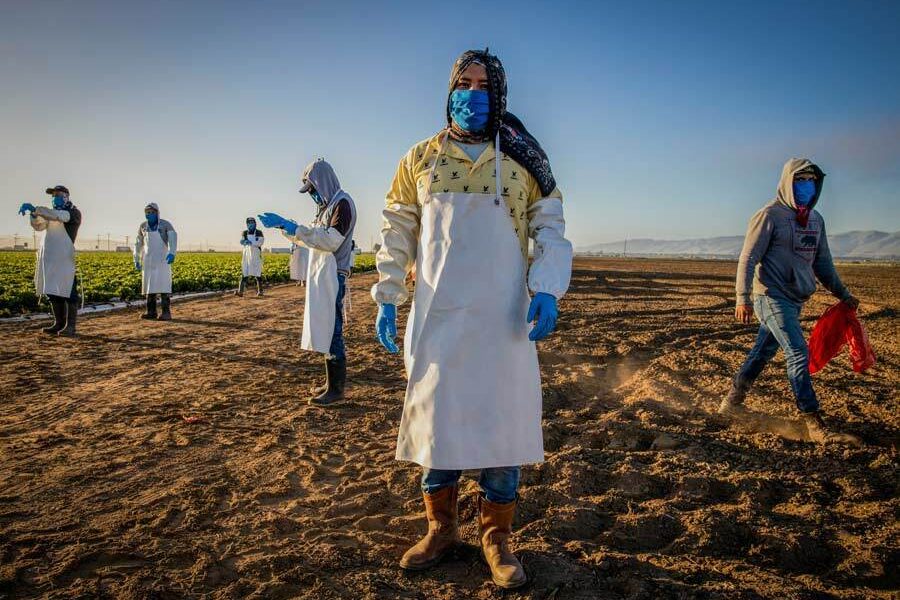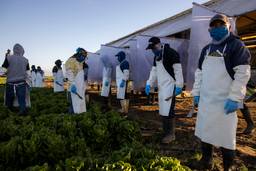The Food Industry’s Next Covid-19 Victims: Migrant Farmworkers
Outbreaks have begun at farms around the country, thanks in large part to crowded employer-provided housing.
Michelle Fawcett and Arun Gupta

AVON, N.Y. — Luis Jimenez, 35, works 66 hours a week tending hundreds of calves at a dairy in upstate New York. He sends $800 home to his parents and eight siblings in Oaxaca, Mexico, every two weeks. “We want to build a house,” he says by phone. “I want my brothers and sisters to go to college.” A calf lows loudly in the background.
Jimenez is president of Alianza Agricola, an advocacy group led by migrant farmworkers. He says dozens of undocumented farmworkers in his organization are particularly vulnerable to the coronavirus. “If one guy gets infected, it’s easy to pass to the others because they live in the same house and come in the same car when they go to work,” he says.
The most widespread outbreak in the food system appears to be among meatpacking workers, with 15,800 documented cases linked to 193 plants, as of May 21. Wired magazine says Covid-19 thrives in the plants because of long hours, crowded workstations, “aggressive ventilation systems” and cold temperatures. But outbreaks on farms are increasing, and they disproportionately affect migrant farmworkers — at least 48% of whom are undocumented.
In These Times identified at least 349 coronavirus cases at 13 farm and agricultural sites in four states. According to farmworkers, medical personnel, advocates, lawyers and media reports, the reason lies in shared migrant housing.
Jimenez and other farmworkers live in so-called congregate living settings, also known as labor camps. Growers usually provide housing for migrants, who may travel thousands of miles for jobs. Jimenez says, on one dairy farm, “Six guys live in a small room, in three bunk beds.” It’s not a house, he says. “It’s a room attached to the farm office.”
Coronavirus outbreaks in upstate New York have hit a dairy, a nursery and a 32-acre greenhouse. At the greenhouse, run by Green Empire Farms, half of its 340 workers who tend tomatoes and strawberries tested positive, one of the state’s biggest outbreaks. According to local health officials, the grower-provided housing had four workers to a room and two to a bed in motels.
Farmworkers “are scared they will get infected and die,” Jimenez says. “We don’t have health insurance. We don’t have access to medical service.”
Woodburn is the epicenter of the Covid-19 outbreak in Oregon — and headquarters to Pineros y Campesinos Unidos de Noroeste, a 7,000-member farmworker union. “Our members work with dozens, sometimes hundreds [of workers], out in the fields, shoulder to shoulder,” says executive director Reyna Lopez, whose parents were migrant farmworkers. “They sometimes live 25 to a house. When one gets it, it spreads like wildfire.”
In central California’s Monterey County, home to the fertile Salinas Valley (with 1.4 million acres of farmland), The Mercury News reports that “unsanitary, overcrowded conditions” in congregate housing are “the perfect recipe for an outbreak.” Farmworkers account for 40% of Monterey County’s 308 confirmed cases as of May 12.
North Carolina has seen outbreaks on five farms with congregate housing. Lori Johnson, managing attorney at the farmworker unit of Legal Aid of North Carolina, says migrant farmworkers “are sharing bathrooms, they are sharing kitchens, the number of bathrooms is low.” Under state law, agribusinesses can cram workers into dorms with as little as 50 square feet per person, one shower for every 10 people and one toilet for every 15.
“The likeliness of everyone in a camp contracting Covid-19 is very high,” says Amy Elkins, an outreach worker for advocacy group NC Farmworkers Project. “The majority of our workers live in barracks with up to 120 workers sharing approximately four toilets and four showers.”
In Salem County, N.J., 59 migrant workers tested positive on one farm, where up to 100 male farmworkers reportedly live in dorms. At an orchard with employer-provided housing in Douglas County, Wash., half of the 71 farmworkers tested positive.
Early indications suggest more outbreaks among farmworkers go unreported. Former dairy worker Wilmer Jimenez, 26, organizes workers on dozens of farms in western New York with the Rural and Migrant Ministry. “The health department confirmed three farm outbreaks. … But I spoke to a lot of other farmworkers who were sick,” he says. In Yakima County, Wash., The Seattle Times reports 70 “farm and fruit-packing workers” have tested positive, but the Yakima Health District estimates about 400 total cases among agriculture workers. In May, workers at six fruit processing facilities in the county went on strike after coworkers fell ill with Covid-19, citing more than 200 health and safety violations.
With 3 million migrant and seasonal farmworkers traveling the United States in the coming months, overcrowded housing may take a serious toll.
“We are some of the most essential workers in the country,” says Sinthia, an immigrant from Guanajuato, Mexico, and one of 60,000 farmworkers who harvest the Salinas Valley during the summer peak. (Sinthia requested anonymity to protect herself, her family and her job.) “Now we have the emotional strain of having to go to work … but always thinking about what will happen with this virus.”






